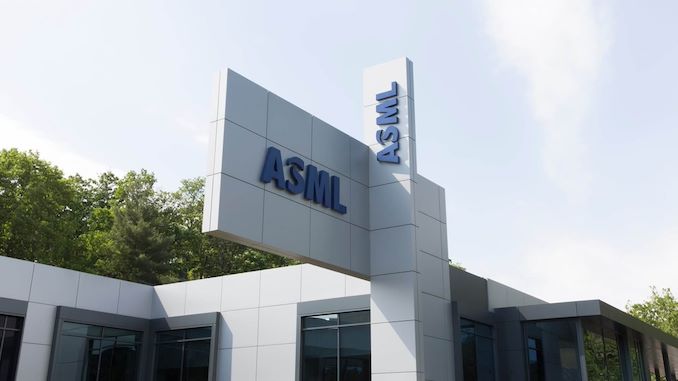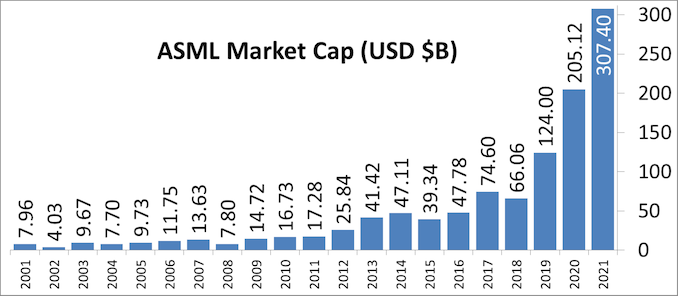Intel's Process Roadmap to 2025: with 4nm, 3nm, 20A and 18A?!
by Dr. Ian Cutress on July 26, 2021 5:00 PM ESTSidebar on Intel EUV
In all of these announcements, one thing to highlight is Intel mentioning its relationship with ASML, the sole company that manufactures the EUV machines powering production of leading edge semiconductor manufacturing.
ASML is a unique company in that it is the only one that can produce these machines, because the technology behind them is often tied up with its partners and research, but also because all the major silicon manufacturers are heavily invested in ASML. For any other company to compete against ASML would require building a separate network of expertise, a decade of innovation and design, and a lot of capital. None of the major silicon vendors want to disturb this balance and go off on their own, lest it shuts them out of the latest manufacturing technology, and no research fund sees competing against the embedded norm as a viable opportunity. This means that anyone wanting EUV specialist technology has to go to ASML.
In 2012, it was reported that Intel, Samsung, and TSMC all invested in ASML. This was, at the time, to jumpstart EUV development along with migrating from 300mm wafers to 450mm wafers. While we haven’t moved to 450mm wafers yet (and there are doubts we will any time in the next decade), EUV is now here. Intel’s 2012 investment of $2.1 billion gave them a 10% stake in ASML, with Intel stating that it would continue investing up to a 25% stack. Those stakes are now below the 5% reporting threshold, but all three of the major foundry customers are still big owners, especially as ASML’s market cap has risen from $24 Billion in 2012 to $268 Billion in 2021 (surpassing Intel).
As major investors but also ASML’s customers, the race has been on for these foundries to acquire enough EUV machines to meet demand. TSMC reported in August 2020 that it has 50% of all EUV machines manufactured at ASML for its leading edge processes. Intel is a little behind, especially as none of Intel’s products in the market yet use any EUV. EUV will only intercept Intel’s portfolio with its new Intel 4 process, where it will be used extensively, mostly on the BEOL. But Intel still has to order machines when they need them, especially as there are reports that ASML currently has backorders of 50 EUV machines. In 2021, ASML is expected to manufacture around 45-50 machines, and 50-60 in 2022. The exact number of machines Intel has right now, or has ordered from ASML, is unknown. It is expected that each one has a ~$150m price tag, and can take 4-6 months to install.
With all that being said, Intel’s discussion point today is that it will be the lead customer for ASML’s next generation EUV technology known as High-NA EUV. NA in this context relates to the ‘numerical aperture’ of the EUV machine, or to put simply, how wide you can make the EUV beam inside the machine before it hits the wafer. The wider the beam before you hit the wafer, the more intense it can be when it hits the wafer, which increases how accurately the lines are printed. Normally in lithography to get better printed lines, we move from single patterning to double patterning (or quad patterning) to get that effect, which decreases yield. The move to High-NA would mean that the ecosystem can stay on single patterning for longer, which some have quoted as allowing the industry to ‘stay aligned with Moore’s Law longer’.
| ASML's EUV Shipments | |||||||||||||||||||||
| 2015 | 2016 | 2017 | 2018 | 2019 | 2020 | 2021 | |||||||||||||||
| Actual | 2 | 4 | 10 | 3 | 4 | 5 | 6 | 4 | 7 | 7 | 8 | 4 | 7 | 14 | 8 | 7 | 9 | - | - | ||
| Target (Total) | - | - | - | 20 (18) | 30 (26) | 35 (33) | 45-50 | ||||||||||||||
| 2018 and beyond is split per quarter for actual shipped numbers Data taken from ASML's Financial Reports |
|||||||||||||||||||||
Current EUV systems are NA 0.33, while the new systems are NA 0.55. ASML’s latest update suggests that it expects customers to be using High-NA for production in 2025/2026, which means that Intel is likely going to be getting the first machine (ASML NXE:5000 we think) in mid-2024. Exactly how many High-NA machines ASML intends to produce in that time frame is unknown, as if they flood the market, having the first won’t be a big win. However if there is a slow High-NA ramp, it will be up to Intel to capitalize on its advantage.













326 Comments
View All Comments
Spunjji - Thursday, July 29, 2021 - link
"TSMC can not satisfy the demand cause low yields"False. We know their yields, and they're good. They can't satisfy demand for many reasons, mainly that they simply don't have enough fabs, but also including literally running out of water.
mode_13h - Sunday, August 1, 2021 - link
> also including literally running out of water.I've heard about the fresh water shortage, but do we know this is actually impacting fab throughput?
zodiacfml - Tuesday, July 27, 2021 - link
wtf is this waste of time. they band-aid their problems with a name change? Intel 10nm is inferior to TSMC 7nm, as I found in their latest 8 core 10nm laptop chips vs AMD's. If you dont believe me, the clue is in TSMCs use of EUV in a few layers of 7nm products. TSMC is no engineering slouch and Intel can't beat physics by just using DUVKeyrock42 - Tuesday, July 27, 2021 - link
Regardless of the naming scheme, the problem for Intel is a lot less about deceptive naming by competitors and a lot more about being able to actually stick to their own roadmap. You can show me an impressively aggressive roadmap and that's all well and good, but my confidence in Intel's ability to stick to said roadmap is at about 2%.DougMcC - Tuesday, July 27, 2021 - link
Seems like the more straightforward naming convention would be based on the density, going ever upward. If the new process offers no advantage in density, you get +, ++ etc. for power improvements and whatnot.mode_13h - Wednesday, July 28, 2021 - link
Makes sense, but I think their 14 nm debacle spoiled the idea of using "+".I'd rather see sequential numbering for major advancements, with letter suffixes for minor ones. Or heck, maybe just a sequential versioning scheme like 2.1 for major.minor improvements.
Spunjji - Thursday, July 29, 2021 - link
That would be nice!six_tymes - Tuesday, July 27, 2021 - link
so many so called enthusiasts are hyper focused on process size, and unfortunately type comments that often read like that of a 12 year old. Most of these types of comments are called trolls, or trolling? What matters in processor technology are results, results in performance and stability. It looks as if this new Intel CEO knows what he is doing, and seems to be steering the ship back in the right direction. I am looking forward to this new competition he is bringing to the industry.diediealldie - Wednesday, July 28, 2021 - link
Can't agree more. Pat showed difficulties ahead and provided how they'll overcome that hardship using technologies only Intel has. He's also brought IDF back which made Intel a great company.It wasn't merely a 1~2 year hyped self-praise, but it was more like long term roadmap to be great again. People are saying that IDM's time is done, but who knows. There are things only IDM can do and Pat seems to know a lot.
mode_13h - Thursday, July 29, 2021 - link
> how they'll overcome that hardship using technologies only Intel has.Uh, the article repeatedly translates between Intel's terms for things and what equivalent or similar things other fabs are working on.